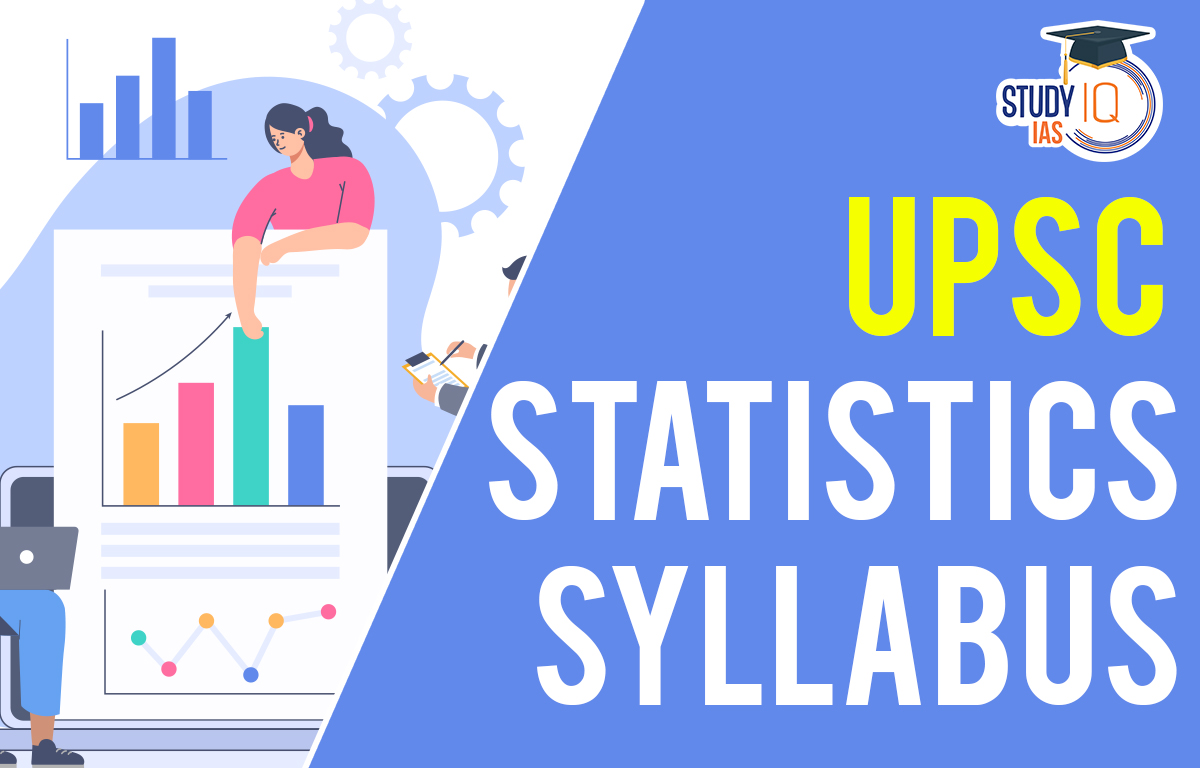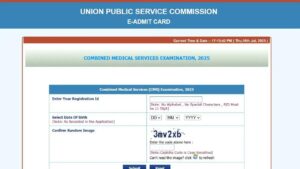Table of Contents
UPSC Statistics Syllabus: Statistics is one of the optional subjects comprising two papers in the UPSC Civil Services Mains Examination (Optional Paper I and Paper II). The UPSC Statistics syllabus for Optional is provided in this article.
UPSC Statistics Optional Syllabus 2024
UPSC Statistics Syllabus includes probability theory, sampling theory, conclusions, and quantitative economics. Aspirants who want to choose Statistics as an optional for the UPSC Mains must familiarise themselves with the UPSC Statistics curriculum.
By combining excellent methods with hard study, aspirants can easily cover the Statistics Optional syllabus. Many applicants believe that statistics are identical to mathematics, however, this is not the case. UPSC Statistics Syllabus can be highly interesting if properly studied.
UPSC CSE Statistics Syllabus 2024 for Paper 1
1. Probability:
- Sample space and events, probability measure and probability space.
- Random variable as a measurable function.
- Distribution function of a random variable.
- Discrete and continuous-type random variables.
- Probability mass function, probability density function.
- Vector-valued random variable.
- Marginal and conditional distributions.
- Stochastic independence of events and of random variables.
- Expectation and moments of a random variable.
- Conditional expectation.
- Convergence of a sequence of random variables in distribution, in probability, in path mean, and almost everywhere.
- Chebyshev’s inequality, Khintchine’s weak law of large numbers, strong law of large numbers, and Kolmogoroff’s theorems.
- Probability generating function, moment generating function, characteristic function.
- Inversion theorem.
- Linderberg and Levy forms of central limit theorem.
- Standard discrete and continuous probability distributions.
2. Statistical Inference:
- Consistency, unbiasedness, efficiency, sufficiency, completeness, ancillary statistics.
- Factorization theorem, exponential family of distribution and its properties.
- Uniformly minimum variance unbiased (UMVU) estimation.
- Rao-Blackwell and Lehmann-Scheffe theorems.
- Cramer-Rao inequality for single Parameter.
- Estimation methods: moments, maximum likelihood, least squares, minimum chi-square, modified minimum chi-square.
- Properties of estimators, asymptotic efficiency.
- Prior and posterior distributions, loss function, risk function, minimax estimator.
- Bayes estimators.
- Non-randomised and randomised tests, critical function, MP tests, Neyman-Pearson lemma, UMP tests.
- Monotone likelihood ratio, similar and unbiased tests, UMPU tests for single parameter likelihood ratio test.
- Confidence bounds and its relation with tests.
- Kolmogorov’s test for goodness of fit, sign test, Wilcoxon signed-ranks test, Kolmogorov-Smirnov two sample test, run test, Wilcoxon-Mann-Whitney test, median test.
- Wald’s SPRT, Oc and ASN functions, Wald’s fundamental identity.
3. Linear Inference and Multivariate Analysis:
- Linear statistical models.
- Theory of least squares and analysis of variance.
- Gauss-Markoff theory, normal equations.
- Least squares estimates and their precision.
- Test of significance and interval estimates based on least squares theory.
- Regression analysis: linear, curvilinear, orthogonal polynomials.
- Multiple regression, multiple and partial correlations.
- Estimation of variance and covariance components.
- Multivariate normal distribution, Mahalanobis’s D2 and Hotelling’s T2 statistics.
- Discriminant analysis, canonical correlations.
- Principal component analysis.
4. Sampling Theory and Design of Experiments:
- Fixed-population and super-population approaches.
- Probability sampling designs: simple random sampling, stratified random sampling, systematic sampling, cluster sampling.
- Two-stage and multi-stage sampling.
- Ratio and regression methods of estimation.
- Two-phase sampling.
- Probability proportional to size sampling.
- Hansen-Hurwitz and Horvitz-Thompson estimators.
- Non-negative variance estimation.
- Fixed effects model, random and mixed effects models.
- Completely randomized design, randomized block design, Latin square design.
- Incomplete block designs, balanced incomplete block design.
- Factorial experiments, confounding, split-plot design, simple lattice designs.
- Duncan’s multiple range test.
UPSC CSE Statistics Syllabus 2024 for Paper 2
1. Industrial Statistics:
- Process and product control.
- General theory of control charts.
- Different types of control charts for variables and attributes: X, R, s, p, np charts, cumulative sum chart.
- Single, double, multiple, and sequential sampling plans for attributes.
- OC, ASN, AOQ, and ATI curves.
- Concepts of producer’s and consumer’s risks, AQL, LTPD, and AOQL.
- Sampling plans for variables, use of Dodge-Romin tables.
- Concept of reliability, failure rate, and reliability functions.
- Reliability of series and parallel systems.
- Renewal density and renewal function.
- Failure models: exponential, Weibull, normal, lognormal.
- Problems in life testing, censored and truncated experiments for exponential models.
2. Optimization Techniques:
- Models in Operations Research, their construction and general methods of solution.
- Simulation and Monte Carlo methods.
- Formulation of Linear Programming (LP) problem, simple LP model and its graphical solution.
- Simplex procedure, two-phase method, M-technique with artificial variables.
- Duality theory of LP and its economic interpretation.
- Sensitivity analysis.
- Transportation and assignment problems.
- Rectangular games, two-person zero-sum games.
- Replacement policies: group and individual.
- Scientific inventory management, analytical structure of inventory problems.
- Storage models with deterministic and stochastic demand with and without lead time.
- Homogeneous discrete-time Markov chains, transition probability matrix.
- Homogeneous continuous-time Markov chains, Poisson process.
- Elements of queuing theory: M/MI, M/M/K, G/M/l and M/G/1 queues.
- Solution of statistical problems using statistical software packages like SPSS.
3. Quantitative Economics and Official Statistics:
- Determination of trend, seasonal, and cyclical components.
- Box-Jenkins method, tests for stationary series, ARIMA models.
- Commonly used index numbers: Laspeyre’s, Paasche’s, Fisher’s ideal index numbers.
- Chain-base index number.
- General linear model, ordinary least square, and generalized least squares methods of estimation.
- Problem of multicollinearity, autocorrelation, heteroscedasticity of disturbances.
- Test for independence of disturbances, concept of structure and model for simultaneous equations.
- Present official statistical system in India relating to population, agriculture, industrial production, trade, and prices.
4. Demography and Psychometry:
- Demographic data from census, registration, NSS, other surveys.
- Vital rates and ratios, measures of fertility, reproduction rates, morbidity rate.
- Standardized death rate, complete and abridged life tables.
- Logistic and other population growth curves, population projection, stable population, quasi-stable population.
- Techniques in estimation of demographic parameters.
- Standardization of scales and tests, Z-scores, standard scores, T-scores, percentile scores.
- Intelligence quotient and its measurement and uses.
- Validity and reliability of test scores, factor analysis, path analysis in psychometry.


 UPSC CMS Admit Card 2025 Out: Download L...
UPSC CMS Admit Card 2025 Out: Download L...
 UPSC Study Material for Prelims & Ma...
UPSC Study Material for Prelims & Ma...
 NATO Countries List 2025, Members, Funct...
NATO Countries List 2025, Members, Funct...





















